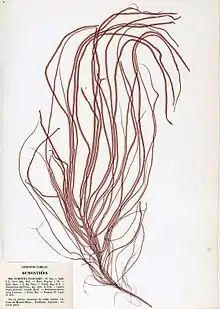Dumontia contorta
Dumontia contorta is a relatively small epiphytic algae of the sea-shore.
| Dumontia contorta | |
|---|---|
 | |
| Scientific classification | |
| (unranked): | Archaeplastida |
| Division: | Rhodophyta |
| Class: | Florideophyceae |
| Order: | Gigartinales |
| Family: | Dumontiaceae |
| Genus: | Dumontia |
| Species: | D. contorta |
| Binomial name | |
| Dumontia contorta | |
Description
The thallus grows from a discoid holdfast to a length of about 23 centimetres (9.1 in). The fronds branch irregularly and sparingly.[2] The branches are hollow, soft and twisted, dark reddish brown in colour which bleach towards the tips, they clearly taper at their junction.[1]
Reproduction
The plants are dioecious (sexes separate) with microscopic spermatangia, carposporangia, and tetrasporangia developing in the surface layer, cruciate.[1][3]
Habitat
Generally epilithic in rock pools of the littoral zone.[1]
Distribution
Common around the British Isles. Europe from Russia to Portugal and Canada to United States. In the NW Pacific and Alaska.[1][4]
References
- Irvine, L.M. 1983. Seaweeds of the British Isles Volume 1 Rhodophyta. Part 2A. British Museum (Natural History) ISBN 0 565 00871 4
- Jones, W.E. 1964. A key to the genera of the British seaweeds. Field Studies 1 no.4:1 - 32
- Bunker,StP,P, Brodie, J.A., Maggs, C.A. and Bunker, A.R. 2017 Seaweeds of Britain and Ireland. Second Edition, Wild Nature Press, Plymouth, UK.ISBN 978-0-9955673-3-7
- Morton, O. 2003. The marine macroalgae of County Donegal, Ireland. Bulletin of the Irish Biogeographical Society No. 27 pp.3 - 164
This article is issued from Wikipedia. The text is licensed under Creative Commons - Attribution - Sharealike. Additional terms may apply for the media files.